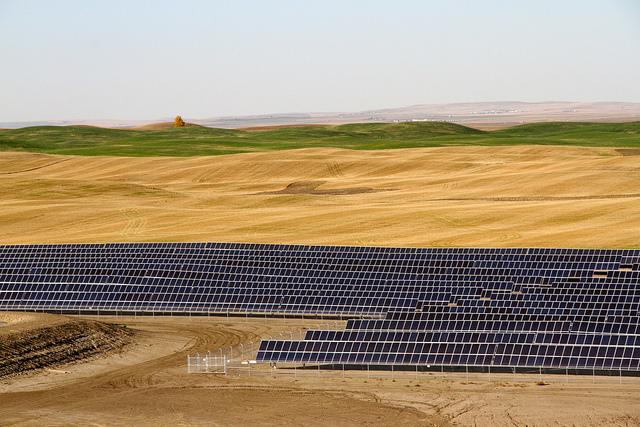As the mercury climbed in Alberta on Wednesday, July 26, it helped bust the myth that baseload is synonymous with reliability. At 2 p.m. the Keephills 2 coal plant tripped offline, and at 3:45 p.m. a second coal plant followed. The failures were most likely a result of the high temperature, which can be problematic for coal generators. All told, by 4 p.m. roughly 2000 MW of coal was offline — almost a third of the installed coal capacity in the province.
As the day went on, and as air conditioners continued to be cranked up, the demand for electricity peaked at over 10,000 MW. This meant that all of the available generating resources in the energy market were used to meet demand. Prices rose to the $1000/MWhr cap, blowing past the 30-day average of roughly $23.
The system operator, AESO, issued a second level emergency alert, launching a series of procedures to avoid blackouts including voluntary load curtailment and reduction in non-essential loads. The system operator was successful, as the load dropped and available capacity in the energy market rose and no outages were reported. However, if Alberta had significant solar PV generation installed this emergency could have been avoided completely. Instead of depending on the coal plants that tripped offline, the same amount of solar capacity in Alberta would have generated enough electricity to avoid any emergency alert and the threat of blackout, while keeping prices under control. For similar energy emergencies caused by high temperatures, solar — which generates most when the sun is shining brightly — is a reliable source of power. It’s a pretty easy choice to make: let’s work with weather, instead of scrambling to adjust to it and risk blackouts.
What does this have to do with baseload myths? The need for baseload to ensure reliable electricity is often touted as the reason to not move away from fossil fuel generation to other sources like wind and solar.
What happened last Wednesday is a stark reminder that baseload isn’t synonymous with reliability — it’s a lot more complicated than that. Let's use this opportunity to explore some of the myths around baseload, and how our understanding of the grid has changed over the years.
The term "baseload" was coined over a hundred years ago. When the electricity grid was first built, large, inflexible fossil fuel generators dominated and played a critical role in the Industrial Revolution. But much like many other aging technologies and approaches, baseload generation is no longer the best tool for the job. Think of it like refusing to get a DVR or Netflix because you already went through the trouble of programming your VCR. Previous understandings of the importance of baseload just aren’t true anymore, but old habits die hard.
Reality: Renewables can provide backup as part of an integrated grid
Renewables that will be built to meet the Alberta renewable energy target won’t require special backup. In fact, there’s no such thing as “special” backup. Every generator on the grid today, whether it's natural gas, coal, nuclear, or renewables has a backup option. This is how the grid reliably provides power, because even fossil power plants routinely shut down for extended maintenance periods, and also suffer unexpected outages. For some coal plants, this accounts for as much as 10 per cent of the time.
[subscribe:moo,align=right]In reality, renewables can contribute to reliability by being available during times of system stress. Often the same phenomena that stress conventional power plants correlate with high levels of renewable generation. In other words, extreme weather can be renewables' time to shine. In addition to the recent example in Alberta, there are well documented cases of wind power helping to prevent blackouts in the U.S. during the recent “polar vortex”, when coal piles were frozen solid and demand for gas for home heating skyrocketed.
The most reliable grid is one that uses a mix of generation types.
Reality: Variability is normal for grid operators
Grid operators are a very talented group of unsung heroes whose accomplishments generally go unacknowledged. They have plenty of training and experience managing variability in both the demand for power and the generation. Operators are able to keep the lights on when large plants come offline unexpectedly or demand for power spikes, by dispatching power on an hourly basis rather than on a daily or monthly basis. In fact, many grids, such as California’s, are transitioning to shorter intervals of 15 minutes for dispatching.
Reality: Renewable variability is predictable and can contribute to reliability
The variability that renewables bring is different, but not harder to manage. While it is less controllable, it’s more knowable — you may not know when a thermal plant will break down but you can forecast wind production with great accuracy. And the variability is in smaller amounts as wind and solar farms are typically smaller in size.
Different solutions will be needed as renewable levels increase significantly above the provincial target of 30 per cent, but there is time to implement these solutions, such as storage and demand response. In many cases, solutions are already starting to be used and tested in jurisdictions with much higher levels of renewables.
Reality: Baseload isn’t the best way to ensure reliability
We can all agree that we need a reliable electricity system. That means power that meets our quality standards should be available when we need it. But baseload is an artifact of old technologies: sticking with the baseload metric will lead to more expensive power. When people use the term "baseload," often what they really mean is reliability. Baseload is an old way to think about providing reliability, and has a lot to do with the inflexibility of power plants. Instead of looking for baseload, we should ask ourselves what services will help maintain system reliability and how can we ensure the market properly values and implements them?
Luckily, we already have an answer. What the grid needs moving forward is more flexible power. Large generators such as coal facilities cannot ramp up and down fast enough to provide grid operators with flexibility. A recent report by the Brattle Group dives deeper into these nuances of baseload and proposes system operators, planners, and market administrators should be paying attention to “a framework that: (a) effectively and efficiently defines and measures system needs and (b) develops planning tools, scheduling processes, and market mechanisms to elicit and compensate broad range of resources that have become available to meet those needs.”
Just a couple of weeks ago, a study requested by the U.S. Energy Secretary Rick Perry — ostensibly to look into the threat of renewables to reliability — proved the exact opposite. An early draft of the study showed that renewables contribute to reliability and that coal power is being edged out by cheap natural gas. This supports what we learned on that hot day in Alberta last week: renewables are needed to support the reliability of the grid, especially with summers getting hotter every year.











